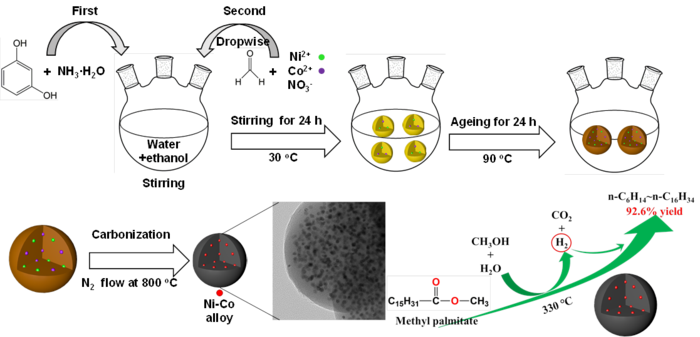Severe energy and environmental problems have been caused by the surplus intake of fossil fuels. As an alternative to fossil fuels, renewable biomass could be converted to chemicals and fuels.
 Novel carbon-coated bimetallic catalyst for in-situ aqueous phase hydrodeoxygenation. Image Credit: Jixiang Chen.
Novel carbon-coated bimetallic catalyst for in-situ aqueous phase hydrodeoxygenation. Image Credit: Jixiang Chen.
For this purpose, lipids that primarily consist of 16 and 18 carbons in fatty acids are highly appropriate for making diesel-like hydrocarbons through hydrodeoxygenation. Conventional hydrodeoxygenation is performed under an external supply of hydrogen at high pressure. But there is a potential safety issue in hydrogen transportation and storage.
Furthermore, commercial H2 is primarily generated from fossil resources. The in-situ hydrogen supply via aqueous phase reforming has gained great attention recently. Realizing this poses the difficulty of designing the catalysts with high resistance to leaching and sintering under rough hydrothermal conditions.
At present, scientists from Tianjin University have developed a carbon-coated metallic catalyst. The study was published online in Frontiers of Chemical Science and Engineering on September 23rd, 2021.
As far as this work is concerned, Professor Chen’s laboratory combined the hydrodeoxygenation of methyl palmitate (a model compound of lipids) and the aqueous reforming of methanol. Importantly, they made a new carbon-coated Ni-Co alloy catalyst through a one-pot extend Stöber process and then carbonized it under N2 atmosphere.
The alloy particles were evenly distributed in the carbon microspheres within the as-prepared catalysts, displaying a “watermelon” structure. This carbon coating structure restricts the leaching and sintering of alloy particles.
Fascinatingly, the existence of Co decreased the size of carbon microspheres, expediting the mass transfer. At the same time, the electronic structure of Ni-Co alloy enables efficient hydrodeoxygenation. Using this carbon-coated Ni-Co alloy catalyst, a hydrocarbon yield of 92.6% can be achieved.
We consider that the carbon-coated metal catalysts are very promising for the in-situ aqueous phase hydrodeoxygenation. Even so, many problems are still required to conquer. For instance, the micro-pore structure in carbon microspheres and the carbon affinity to organic reactants easily cause the pores block and subsequently lead to the catalyst deactivation. Constructing more meso-pores in carbon microspheres is urgently needed in the future work.
Jixiang Chen, Professor, California State University
In the study by Professor Chen, a novel facile route was suggested to make a carbon-coated bimetallic catalyst. A carbon-coated methodology was discovered to enhance hydrothermal stability greatly. This study augments the development of the catalyst for biomass upgrading in an aqueous system and further pushes the biomass valorization forward.
Journal Reference:
Shi, Y., et al. (2021) Carbon-coated Ni-Co alloy catalysts: preparation and performance for in-situ aqueous phase hydrodeoxygenation of methyl palmitate to hydrocarbons using methanol as the hydrogen donor. Frontiers of Chemical Science and Engineering. doi.org/10.1007/s11705-021-2079-1.